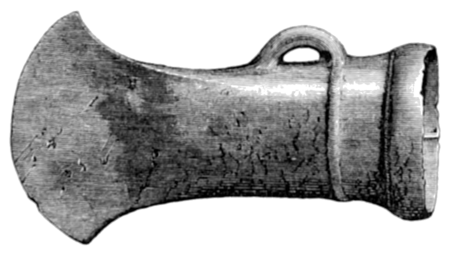tially buried in this deposit there lay a well patinated celt of the socketed type, in perfect preservation. It lay upon its side, with the cutting edge inclining upwards, and turned towards the centre of the mound. (Fig. 1.) Its extreme length is 314 in. the width of the cutting edge is 134 in., and the diameter of the socket, which is nearly circular, is about 114 in.; it has a small car or loop upon one side, and both externally and internally preserves the ridge or seam left at the joint of the mould at the time that it was cast. With the exception of a narrow band of slight elevation which encircles the weapon in a plane coincident with the anterior end of the loop, it is destitute of any attempt at ornamentation. The sides appear to have been hammered, and the cutting edge presents evident signs of wear, especially towards the extremity of the side opposite to that on which the loop is placed. The same is also the case with another celt of similar type obtained at Honiton, and supposed to have been originally brought from Lovehayne, near Broad Down.[1]
Fig. 1.—Bronze socketed celt, found in a kist-vaen, in a barrow on Broad Down, near Honiton. Length, 314 in.
Albert Memorial Museum, Exeter.
This fact appears not unworthy of notice when we attempt to explain the precise mode of mounting these curious implements, for, if they were fastened to a wooden handle by means of a thong which was also attached to the loop (as is supposed to have been the case), would not the upper portion of the cutting edge have shown more marked signs of Wear? I have dwelt at some length upon the fact of the discovery of this celt, both because it is the first of its kind that has been found in the barrows of East Devon, and also because the fact of its burial with its owner affords a glimpse of the mental and moral feeling which actuated the sur-
- ↑ Figured in this Journal, vol. xxvi. p. 313.

